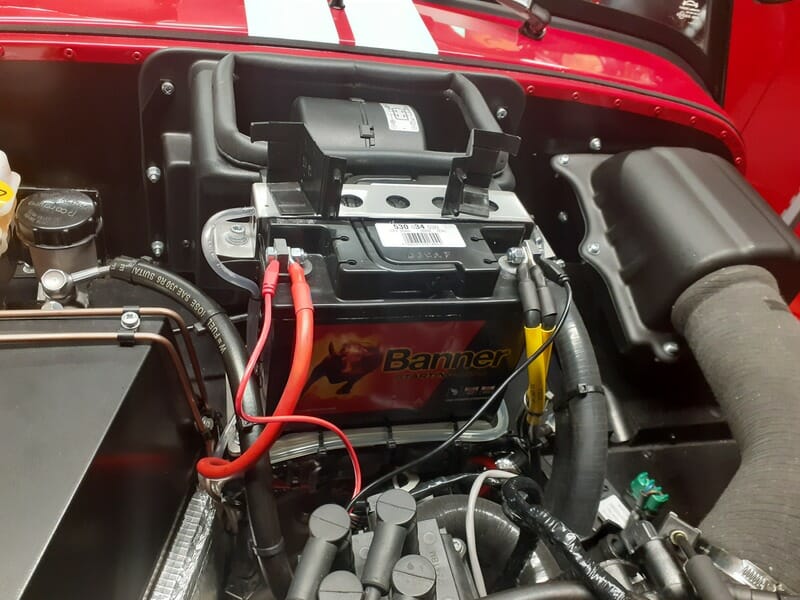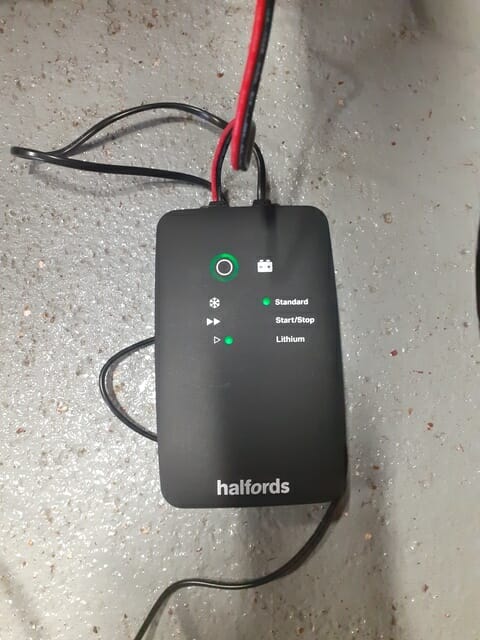Your battery will go flat if you leave it unattended, even with a master cut-off switch.
To prevent this, it’s a good idea to trickle charge. Various things can drain the battery, such as the immobiliser. While a battery cut off switch can help (I have one), the battery can still die given enough time, especially if left in cold conditions. If you leave the car in a garage for 6 months, you might struggle to get it started.
Whilst I didn’t do this, if I was to build again, I would remove the battery from the car when it is delivered and hook it up to a trickle charger out of the way. This depends on how long you will take to complete the build, but a battery left alone for a year is bound to degrade! This will save you the money having to replace it…
I found this out the hard way when I fitted my LED lights and then the car was misbehaving and the lights weren’t turning on. The car was making all sorts of weird noises as well. Great I thought, haven’t even driven it yet! Spent ages checking wiring, relays and fuses, before just charging the battery. Even after a full charge on the battery, it was still knackered, but at least I could get some lights to come on. I took the battery to Halfords who put it on a battery tester – it should score 300A, mine scored 37A, even after I had fully charged it! “Replace advised” the machine said…
I took the opportunity to do a bit of revision on how batteries actually work, there’s a lot of good stuff on youtube. This is a really, really simple summary – batteries convert chemical energy into electrical energy. In the Banner 53034 which is fitted as standard in Caterhams now, there are 6 cells. Inside each cell are thin lead plates and between the lead is acid. Each cell is connected to the next one, hence ‘battery’. This is why you see 6 plugs on the top of the battery, you can open these plugs to check the acid levels inside/top up – not that I plan on doing this.
Due to chemical reactions the acid and lead react, freeing up electrons. Electrons travel to the negative terminal where they hang around, just waiting for a way to get to the positive terminal. This is why you always disconnect the negative first and connect the negative last, because the electrons are coming out of this negative terminal and moving towards the positive terminal. If you don’t do this you can get sparking.
When you recharge a battery, by pumping electricity into it, the chemical reaction reverses. Just be aware that charging the battery can cause Hydrogen and Oxygen to be given off. This is normal. While these aren’t poisonous, you don’t really want to do it in your house as these are very flammable (hence no smoking, sparks etc). This is also why some batteries, including the Banner battery, need to be vented – that is the tube coming out of the battery and it gives the gas somewhere to go. If you charge a battery with its vents blocked it can build up pressure and explode.
The vents on the banner are two small holes at the top, on either side by the terminals. One of these may be blocked. You only need one vent open. The car originally came fitted with a battery and vent tube coming from near the positive terminal, but my replacement battery the open vent was the negative side, so I got a new vent tube with the replacement battery and fitted the vent tube from the negative side (leaving the positive tube in place in case I need it in future). This way I can connect a tube on either side easily next time I have to replace the battery.
If you leave a battery unattended, or let it run too low without recharging, then the battery can die because the chemical reaction completes (massive simplification). Then recharging won’t do anything, except make the battery sound like a fizzy drink. Which is what happened to me.
Not many places stock these Banner batteries so it is easier to get online. I ordered mine from Tayna along with a new vent tube (about 2 quid), they did next day delivery via Yodel with a courier who didn’t understand the arrow and ‘this way up’. Gloves on, I unpacked the battery (exceptionally well packed) and wiped off the small amount of acid that had leaked out. The battery gets shipped filled with acid (some batteries they ship the acid in bottles and you have to add it yourself). The vent hole was plugged for transport so acid doesn’t leak out everywhere. There was a red plug on the negative side, I removed this straightaway – make sure you don’t charge with this fitted! I left the white plug fitted on the positive side.
For good order I then took the battery up to Halfords (they offer battery testing for free, you can buy decent battery testers for around 50 quid online) and I got it tested on the same machine – 317A on the new vs 37A on the dead battery. So all good there! Battery was fully charged.
I fitted the new battery, with the new vent tube I also ordered from Tayna, and routed this vent tube across the front of the battery and down by the existing vent tube that was pre-fitted on the car, using zip ties. I’ll keep an eye on this, but it was easier than fitting going down the LHS:

Now I turned on the car, started first time no issues, left it to run for a bit as it has been a few months. I can’t wait to drive this.
With the new battery fitted, I hooked up my trickle charger. There are lots of trickle chargers available, a very popular choice being the C-TEK. However, my Halfords charger has a trickle charge mode. It comes with interchangable normal grips, and ring terminals to connect to the battery. As I’m going to be leaving this for a long time, I bolted the wires from the trickle charger to the battery as you can see from this photo:

Note plastic caps on battery removed for photo, but keep these on.
Then turn on the Halfords charger, hit the button to select trickle mode and leave it. When the green light blinks it is charging, solid green light means it is charged and monitoring:

Anytime I’m leaving the car longer than a few days, I will connect the trickle charger. As I say loads of other brands available for trickle charging, it’s worth doing.